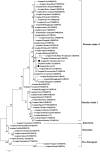A Comprehensive Review on Equine Influenza Virus: Etiology, Epidemiology, Pathobiology, Advances in Developing Diagnostics, Vaccines, and Control Strategies
- PMID: 30237788
- PMCID: PMC6135912
- DOI: 10.3389/fmicb.2018.01941
A Comprehensive Review on Equine Influenza Virus: Etiology, Epidemiology, Pathobiology, Advances in Developing Diagnostics, Vaccines, and Control Strategies
Abstract
Among all the emerging and re-emerging animal diseases, influenza group is the prototype member associated with severe respiratory infections in wide host species. Wherein, Equine influenza (EI) is the main cause of respiratory illness in equines across globe and is caused by equine influenza A virus (EIV-A) which has impacted the equine industry internationally due to high morbidity and marginal morality. The virus transmits easily by direct contact and inhalation making its spread global and leaving only limited areas untouched. Hitherto reports confirm that this virus crosses the species barriers and found to affect canines and few other animal species (cat and camel). EIV is continuously evolving with changes at the amino acid level wreaking the control program a tedious task. Until now, no natural EI origin infections have been reported explicitly in humans. Recent advances in the diagnostics have led to efficient surveillance and rapid detection of EIV infections at the onset of outbreaks. Incessant surveillance programs will aid in opting a better control strategy for this virus by updating the circulating vaccine strains. Recurrent vaccination failures against this virus due to antigenic drift and shift have been disappointing, however better understanding of the virus pathogenesis would make it easier to design effective vaccines predominantly targeting the conserved epitopes (HA glycoprotein). Additionally, the cold adapted and canarypox vectored vaccines are proving effective in ceasing the severity of disease. Furthermore, better understanding of its genetics and molecular biology will help in estimating the rate of evolution and occurrence of pandemics in future. Here, we highlight the advances occurred in understanding the etiology, epidemiology and pathobiology of EIV and a special focus is on designing and developing effective diagnostics, vaccines and control strategies for mitigating the emerging menace by EIV.
Keywords: control; diagnosis; epidemiology; equine; influenza virus; pathogenesis; prevention; vaccine.
Figures





Similar articles
-
Equine Influenza Virus and Vaccines.Viruses. 2021 Aug 20;13(8):1657. doi: 10.3390/v13081657. Viruses. 2021. PMID: 34452521 Free PMC article. Review.
-
Equine Influenza Virus in Asia: Phylogeographic Pattern and Molecular Features Reveal Circulation of an Autochthonous Lineage.J Virol. 2019 Jun 14;93(13):e00116-19. doi: 10.1128/JVI.00116-19. Print 2019 Jul 1. J Virol. 2019. PMID: 31019053 Free PMC article.
-
How to Meet the Last OIE Expert Surveillance Panel Recommendations on Equine Influenza (EI) Vaccine Composition: A Review of the Process Required for the Recombinant Canarypox-Based EI Vaccine.Pathogens. 2016 Nov 25;5(4):64. doi: 10.3390/pathogens5040064. Pathogens. 2016. PMID: 27897990 Free PMC article. Review.
-
Refinement of the equine influenza model in the natural host: A meta-analysis to determine the benefits of individual nebulisation for experimental infection and vaccine evaluation in the face of decreased strain pathogenicity.Vet Microbiol. 2017 Nov;211:150-159. doi: 10.1016/j.vetmic.2017.10.010. Epub 2017 Oct 10. Vet Microbiol. 2017. PMID: 29102112
-
Genome-informed characterisation of antigenic drift in the haemagglutinin gene of equine influenza strains circulating in the United States from 2012 to 2017.Transbound Emerg Dis. 2022 Jul;69(4):e52-e63. doi: 10.1111/tbed.14262. Epub 2021 Aug 17. Transbound Emerg Dis. 2022. PMID: 34331828
Cited by
-
S-Acylation of Proteins of Coronavirus and Influenza Virus: Conservation of Acylation Sites in Animal Viruses and DHHC Acyltransferases in Their Animal Reservoirs.Pathogens. 2021 May 29;10(6):669. doi: 10.3390/pathogens10060669. Pathogens. 2021. PMID: 34072434 Free PMC article.
-
Genetic and serologic surveillance of canine (CIV) and equine (EIV) influenza virus in Nuevo León State, México.PeerJ. 2019 Dec 17;7:e8239. doi: 10.7717/peerj.8239. eCollection 2019. PeerJ. 2019. PMID: 31871842 Free PMC article.
-
Immunoinformatics and Vaccine Development: An Overview.Immunotargets Ther. 2020 Feb 26;9:13-30. doi: 10.2147/ITT.S241064. eCollection 2020. Immunotargets Ther. 2020. PMID: 32161726 Free PMC article. Review.
-
Full-Length Genome of the Equine Influenza A Virus Subtype H3N8 from 2019 Outbreak in Saudi Arabia.Animals (Basel). 2022 Oct 10;12(19):2720. doi: 10.3390/ani12192720. Animals (Basel). 2022. PMID: 36230462 Free PMC article.
-
Voluntary Surveillance Program for Equine Influenza Virus in the United States during 2008-2021.Pathogens. 2023 Jan 27;12(2):192. doi: 10.3390/pathogens12020192. Pathogens. 2023. PMID: 36839464 Free PMC article.
References
-
- Alves Beuttemmüller E., Woodward A., Rash A., dos Santos Ferraz L. E., Fernandes Alfieri A., Alfieri A. A., et al. . (2016). Characterisation of the epidemic strain of H3N8 equine influenza virus responsible for outbreaks in South America in 2012. Virol J. 13:45. 10.1186/s12985-016-0503-9 - DOI - PMC - PubMed
Publication types
LinkOut - more resources
Full Text Sources
Other Literature Sources
Miscellaneous

